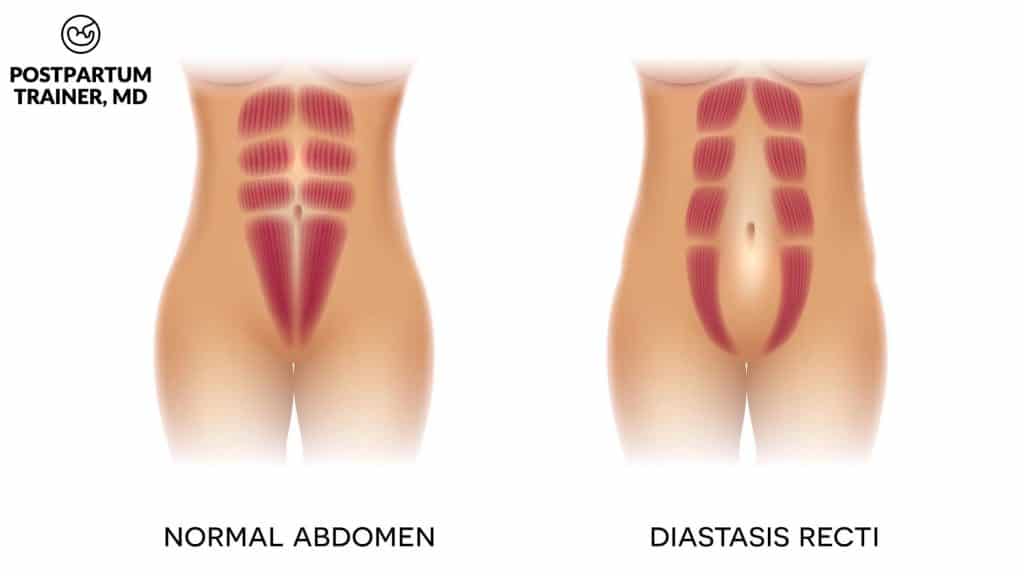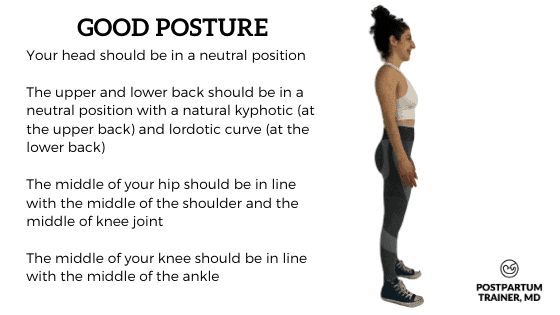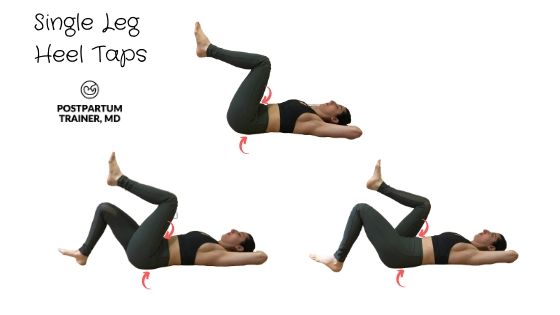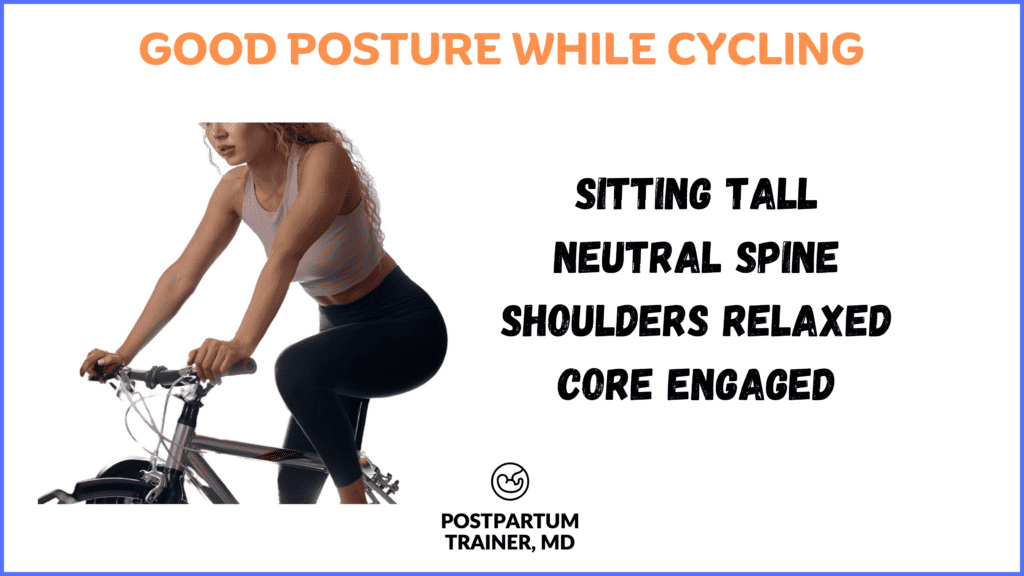Are you eager to jog after pregnancy but recovering from diastasis recti?
Are you worried that it might worsen your abdominal separation?
The short answer is yes. Jogging can exacerbate diastasis if you do not do it correctly.
In this post, you will learn:
- Four prerequisites you need before jogging with diastasis
- When and how to start your jogging routine
- Other alternatives you can consider
Let’s get started.
What is Diastasis Recti?
Diastasis recti occurs when the abdominal muscles separate along the midline. It is often due to a weakness in the connective tissue between the rectus abdominis muscles. (Aka the linea alba)
Pregnancy is a big risk factor for developing this condition. Just think about how much your muscles need to stretch to accommodate the growing uterus.
The good news is, in most cases, the gap will heal naturally as the uterus shrinks.
But, in some cases, the abdominal wall separation may persist for years.

You have minor diastasis if the separation between your muscles is 1-2 finger widths.
A wider split of 3 cm or more is severe. Left untreated, it can cause core weakness, lower back pain, and pelvic floor dysfunction.
An OBGYN or physical therapist can assess your gap (around the belly button) with a physical exam.
When Can I Start Jogging With Diastasis?
You can start jogging with diastasis recti once you get medical clearance from your provider. For most women, this is at six weeks postpartum.
But it’s also important that you are honest with yourself about your recovery.
If you don’t feel up for it, that’s okay.
Just wait. It is always better to rest and heal than to rush it.
You can use this time to continue going on slow walks and rebuilding your core and pelvic floor.
Prerequisites You Need Before You Start Jogging With DR
Before you start jogging with diastasis recti, you should meet the following prerequisites:
- You should see improvement in the gap between your rectus abdominis muscles.
- You should be able to do basic exercises like squats and hip bridges with no pain.
- You must be able to engage your core when doing any exercise.
- You must be able to keep your pelvis and spine in neutral alignment.
I always tell my patients that the first thing to focus on during the first six weeks are:
1. Strengthening the pelvic floor muscles
2. Doing gentle abdominal exercises to help close the abdominal separation.
3. Focusing on good postpartum posture

Almost every postpartum woman will have weaknesses in these areas. Postpartum running or jogging can worsen these conditions.
How To Take Care of Your Core and Pelvic Floor
The safest way to start running is to first build a strong core.
You need to identify and strengthen the muscles that stabilize the muscles of the core and the hips.
The most important are the deep core muscles. These include the transverse abdominis and internal obliques.
Strengthening these muscle groups will serve three purposes. Improve your posture, support your spine, and reduce the risk of injury and low back pain.
Start with gentle core exercises like:
- heel slides,
- toe taps,
- pelvic tilts, and
- abdominal bracing exercises.

Studies have shown that exercise programs can reduce diastasis in female runners. The best part is it followed them for up to 2 years postpartum [source].
I cover all these exercises and more in my DR exercise guide.
Avoiding activities like crunches, sit-ups, and planks is also essential. These exercises overly stimulate the rectus abdominis, which can worsen the gap.
As far as the pelvic floor muscles, Kegels are the best exercise.
You can do these exercises anywhere and anytime, but you have to remember to do them.
Learn more about Kegels and other pelvic floor exercises here.
You can also consider seeing a physical therapist to ensure you are ready to jog!
How To Begin Jogging After Pregnancy
Once you have strengthened your pelvic floor and core, it’s okay to start jogging.
But remember to take it slow.
Start by jogging on soft surfaces or a treadmill. Avoid hills or uneven surfaces at first.
Begin with 10-15 minute slow walks and increase as you feel ready.
A slow pace allows your body to adapt to physical activity without excessive impact.
Also, pay close attention to your running form.
This step is crucial.
Keep your head neutral, shoulders back, chin tucked, spine neutral, and abs engaged.
Also, do not over-stride. Allow your feet to land under your body, and focus on the quality of each step.
Other Tips To Stay Safe Safe Once You Start
Let’s review a few other tips once you start your jogging routine.
1. Consider investing in an abdominal binder. A binder or support belt can provide extra core support and compression when jogging.
I used one of these braces for the first couple weeks after delivering my baby. Here is the one I’ve tried and recommend.
2. Check your shoes: Good jogging shoes provide proper arch support and shock absorption. The Hoka brand has become a popular jogging shoe. These can reduce the impact on your feet and, thus, your legs.
3. Listen to your body: Stop if you feel any pain or discomfort. Red flags include pulling, bulging, coning, or increased separation.
4. Be patient: Diastasis recti can take six months or longer to heal all the way. Don’t rush your return to jogging if the connective tissue in your belly is still weak.
5. Take ample walking breaks: Don’t be afraid to scale back your workout to catch your breath. Breathing too fast can make you lose the integrity of your core muscles.
Now, let’s go over some risks.
Risks of Jogging with Diastasis Recti
Jogging with diastasis recti carries some risks that new moms should be aware of.
The force generated by jogging can worsen the separation between the abdominal muscles.
Without a strong core, you are also at higher risk for poor running form. Improper technique can lead to strains, discomfort, and other injuries.
Additionally, jogging too soon after pregnancy poses extra skeletal risks. Your body may still have elevated levels of relaxin hormone. This hormone loosens the joints and ligaments of your body to prepare for childbirth.

As such, doing too much too soon can increase the risk of hip pain, knee pain, or pelvic pain.
Remember, the key is to progress at your own pace. You can then adapt your exercise routine according to your body’s healing process.
Benefits of Jogging with Diastasis Recti
While jogging with diastasis recti requires several precautions, it also has many benefits.
Here is a list of the benefits jogging can provide:
- Help you regain stamina and energy levels after childbirth,
- Promote bone and muscle strength by stimulating bone mineral density,
- Increases core stability,
- Improves mood and relieves stress as the body releases endorphins,
- Provides you with a much-needed break and a sense of routine,
- Targets the leg muscles,
- Burns calories and reduces weight gain,
- Supports the body’s return to its pre-pregnancy state.
Alternative Cardio Options In The Postpartum Period
If jogging does not work for you, there are a lot of other cardio exercises that you could do with DR.
One of the best exercises is walking.
Walking is an excellent option and very underrated.
It’s a low-impact exercise that allows you to build your fitness over time. It’s also easy to incorporate it into your daily routine.
You can start with short walks and increase the distance and speed as you feel ready.
Swimming is another great, low-impact cardio activity that trains your entire body.
The buoyancy of the water supports your body weight, which reduces abdominal pressure.
Water aerobics classes are another fun and engaging way to get a cardio workout.
The water offers resistance while reducing the impact on your joints. It is also gentle on the rectus abdominis muscle.
Many pools and gyms offer water aerobics classes designed for postpartum women. Be sure to ask your local gym!
A stationary bike is another great cardio alternative.

Cycling allows you to build cardio intensity without high tension on the abdominals. (Learn more about cycling with DR here).
Also, yoga and pilates are other great options for a postpartum cardio workout.
Take caution to avoid crunches, extensive twisting, or exercises that cause abdominal discomfort.
Final Words About Jogging With Diastasis Recti
With proper precautions, jogging can be safe and beneficial with diastasis recti.
It’s important to remember to take it slow, focus on proper form, and listen to your body.
When in doubt, you can always seek advice from a qualified physical therapist (DPT) familiar with postpartum women.
Take the time to build a strong foundation, and you can start jogging again!
Other Related Articles
- Diastasis Recti Cardio: What’s Safe & What Isn’t?
- Cycling With Diastasis Recti How To Get Back To It!
Get Four Free Workouts To Help Strengthen Your Pelvic Floor & Heal Your Mommy Tummy!

Brittany Robles, MD, MPH, CPT
Brittany Robles is a full-time OBGYN physician, a NASM certified trainer, and a prenatal and postnatal fitness specialist. She holds a Master of Public Health degree in maternal health with a special interest in exercise and nutrition. She is also the co-author of The White Coat Trainer. Learn more about her here.
Sharing is Caring – Send This To A Mom In Need!
